Embarking on an RV adventure is an exhilarating experience, but to truly make the most of it, you need a reliable source of power to fuel your journey. That’s where choosing the right RV battery becomes crucial.
The RV battery is the heartbeat of your mobile home, providing the power needed to run essential systems, keep your appliances humming, and keep you connected to the modern conveniences you love. Whether you’re exploring the rugged outdoors or parking at a cozy campsite, having a dependable and long-lasting battery is essential to power your adventures and keep your RV functioning smoothly.
In this article, we will explore the top five RV batteries that have proven their worth among avid travelers. These batteries have been meticulously selected based on their performance, durability, and ability to meet the demanding power needs of RV enthusiasts. We will delve into their key features, benefits, and what sets them apart from the competition.
From deep-cycle batteries designed to handle long trips to lithium-ion options offering extended lifespan and lightweight convenience, we will cover a range of options to cater to different preferences and budgets. By the end of this guide, you will be equipped with the knowledge needed to make an informed decision and choose the best RV battery to power your adventures, ensuring a worry-free journey as you explore the open road.
Contents
- What is an RV House Battery?
- How Does an RV Battery Work?
- What Are Different Types of RV Batteries?
- Best RV Deep Cycle Batteries: In-depth Reviews
- 1. Renogy Deep Cycle AGM Battery 12 Volt 100Ah
- 2. WEIZE 12V 100Ah LiFePO4 Lithium Battery for RV, Off-Grid Application
- 3. ExpertPower 12V 100Ah Lithium LiFePO4 Deep Cycle Rechargeable Battery
- 4. Battle Born Batteries LiFePO4 Deep Cycle Battery
- 5. WindyNation 100 amp-Hour 100AH 12V 12 Volt AGM Deep Cycle
- RV Battery Buying Guide: Factors to Consider
- Who Makes The Best Camper Battery?
- RV Battery FAQs
What is an RV House Battery?
RV batteries, also known as house batteries, are a type of battery specifically designed to power the electrical systems and appliances in a recreational vehicle (RV). Unlike the vehicle’s starting battery, which is responsible for starting the engine, the RV battery serves as a source of power for the various onboard systems when the RV is not running or connected to shore power.
These batteries are typically deep-cycle batteries, built to provide a consistent and sustained flow of power over an extended period. These batteries are designed to handle the deep discharge and recharge cycles that are common in RV usage.
House batteries are typically located in the RV’s battery compartment, which is usually located under the RV. They are connected to the RV’s electrical system by a series of cables.
The number of house batteries that an RV needs will depend on the size of the RV and the electrical appliances that are used. A small RV may only need one house battery, while a large RV may need two or more.

How Does an RV Battery Work?
The way an RV battery works is by storing chemical energy and converting it into electrical energy. The chemical reaction that takes place inside the battery is called an electrochemical reaction. This reaction involves the movement of electrons between the positive and negative terminals of the battery. Let’s dive into the process:
Chemical reaction: RV batteries consist of cells containing positive and negative plates immersed in an electrolyte solution. When a load, such as a light or a refrigerator, is connected to the battery, a chemical reaction occurs between the plates and the electrolyte.
Electrical flow: The chemical reaction causes electrons to be released from the negative plates, creating a surplus of electrons at the negative terminal. Simultaneously, the positive plates accept these electrons, resulting in a deficiency of electrons at the positive terminal. This difference in electron concentration creates an electrical potential difference, generating voltage.
Powering the RV: As the RV battery is connected to the electrical system of the vehicle, the voltage difference allows the flow of electrons through the circuits. The electrical energy powers lights, water pumps, appliances, fans, and other onboard systems, providing the necessary functionality while disconnected from external power sources.
Charging and recharging: As the battery discharges, the chemical reaction slows down and eventually stops. When the battery is completely discharged, it needs to be recharged. The battery can be recharged by connecting it to a power source, such as a generator or shore power. The charging process reverses the electrochemical reaction that takes place when the battery is discharging. The electrical energy from an external source causes a reverse chemical reaction, replenishing the stored energy in the battery. This allows the battery to be recharged for subsequent use.
What Are Different Types of RV Batteries?
There are several types of RV batteries available on the market, each with its own purpose, operation, and specifications. It is important to understand the different types of RV batteries so that you can make an informed decision when choosing one for your RV.
There are 4 main types of RV batteries including Flooded lead-acid batteries, Gel batteries, AGM batteries and Lithium-ion batteries. By considering the distinct characteristics as well as pros & cons of each battery type, you’ll be able to choose the best power solution for your camper.
Flooded Lead Acid Batteries
Flooded lead-acid batteries, also known as wet-cell batteries, are a traditional type of lead-acid battery. They have been used for many years and are still widely employed in various applications, including automotive, marine, industrial, and backup power systems.
Flooded lead-acid batteries consist of a plastic container filled with a liquid electrolyte solution, typically a mixture of sulfuric acid and distilled water. The battery plates, which are made of lead, are immersed in the electrolyte. During operation, the chemical reactions between the electrolyte and the battery plates generate electrical energy.
One of the main characteristics of flooded lead-acid batteries is that they require regular maintenance. This includes periodically checking and replenishing the electrolyte levels by adding distilled water to compensate for evaporation or electrolyte loss. The water level must be monitored to ensure that the battery plates remain fully submerged in the electrolyte, as exposing them to air can cause irreversible damage.
Flooded lead-acid batteries also require proper ventilation due to the potential release of hydrogen gas during charging. This gas can be hazardous and needs to be safely vented to prevent the risk of explosion.
Despite their maintenance requirements, flooded lead-acid batteries offer several advantages. They are known for their relatively low cost compared to other battery technologies. They also have the ability to deliver high surge currents, making them suitable for applications that require a quick burst of power, such as starting engines or powering heavy machinery.
Flooded lead-acid batteries can withstand deep discharge cycles, which means they can be discharged to a relatively low state of charge without significant performance degradation. This makes them suitable for applications that require regular cycling, such as renewable energy systems.
However, flooded lead-acid batteries have some limitations. They are more susceptible to damage from overcharging and deep discharging compared to other battery types. Additionally, their maintenance requirements, including regular electrolyte checks and water refilling, can be time-consuming and require careful handling.
Gel Batteries
Gel batteries, also known as gel-cell batteries or gel electrolyte batteries, are a type of valve-regulated lead-acid (VRLA) battery. They are commonly used in applications that require a reliable and maintenance-free power source, such as uninterruptible power supplies (UPS), telecommunications systems, and emergency lighting.
The key characteristic of gel batteries is the use of a gel-like electrolyte instead of the liquid electrolyte found in traditional lead-acid batteries. The gel electrolyte is made by mixing sulfuric acid with a silica additive, which creates a thick, immobilized gel substance. This gel-like consistency helps to immobilize the electrolyte, preventing it from flowing freely within the battery.
The gel electrolyte offers several advantages over liquid electrolytes. Firstly, it provides enhanced resistance to vibration and shock, making gel batteries more durable and suitable for applications where mechanical stress is a concern. Secondly, the gel electrolyte reduces the risk of acid leakage, as it is contained within the gel matrix. This improves the safety and allows for more flexible battery placement.
Gel batteries are also known for their deep cycle capabilities. They can withstand repeated deep discharges without suffering significant performance degradation, making them suitable for applications that require regular and deep cycling, such as renewable energy systems and electric vehicles.
In terms of maintenance, gel batteries are considered to be virtually maintenance-free. They do not require the addition of water, as the gel electrolyte does not evaporate like the liquid electrolyte in traditional lead-acid batteries. However, proper charging practices should still be followed to maximize the battery’s lifespan.
It’s important to note that gel batteries have a slightly lower energy density compared to some other battery types, such as lithium-ion batteries. This means they may have a larger physical size and weight for a given capacity. However, their reliability, durability, and ease of use make them a popular choice for many applications that prioritize safety and maintenance-free operation.
Absorbent Glass Mat Batteries
AGM batteries, short for Absorbent Glass Mat batteries, are a type of valve-regulated lead-acid (VRLA) battery. They are commonly used in various applications, including automotive, marine, recreational vehicles, and renewable energy systems.
AGM batteries employ a unique construction that involves a glass mat separator saturated with electrolyte between the battery plates. The glass mat is made of a highly absorbent and fine fiberglass material, which is designed to hold and evenly distribute the electrolyte throughout the battery. This design eliminates the need for a free-flowing liquid electrolyte found in traditional lead-acid batteries.
The key advantages of AGM batteries lie in their maintenance-free operation and improved performance characteristics. They are considered to be sealed batteries, as the electrolyte is immobilized within the glass mat separator and does not require periodic refilling. This makes them spill-proof and eliminates the risk of acid leakage, allowing for safe installation in various positions.
AGM batteries for RV also have a lower internal resistance compared to traditional flooded lead-acid batteries. This results in several benefits, including faster charging times, higher discharge rates, and better tolerance to deep discharges. AGM batteries can deliver a high amount of current in a short period, which makes them suitable for applications that require a quick burst of power, such as starting engines or operating power-hungry equipment.
Furthermore, AGM batteries exhibit excellent cycling capabilities. They can endure a higher number of charge-discharge cycles compared to traditional flooded batteries without significant loss of performance, making them suitable for applications that require regular deep cycling, such as off-grid solar power systems.
It’s important to note that AGM batteries still require proper charging practices to ensure optimal performance and lifespan. Overcharging or undercharging can negatively impact their performance and longevity. Therefore, it is recommended to use chargers specifically designed for AGM batteries.
Lithium-ion Batteries
Lithium-ion deep cycle batteries are a type of rechargeable battery specifically designed for deep discharge and extended cycling applications. They are commonly used in various energy storage systems, such as RV camping, renewable energy systems, electric vehicles, marine applications, and off-grid power systems.
RV deep cycle batteries are designed to be discharged to a greater extent compared to regular starting batteries without suffering significant performance degradation. This means they can provide a steady and reliable power supply over a longer period of time.
Lithium-ion deep cycle batteries offer several advantages over other types of batteries. They have a high energy density, meaning they can store a large amount of energy relative to their size and weight. They also have a low self-discharge rate, which allows them to retain their charge for longer periods when not in use. Furthermore, lithium-ion batteries have a longer lifespan and can withstand a higher number of charge-discharge cycles compared to traditional lead-acid batteries.
The use of lithium-ion technology in deep cycle batteries provides efficient energy storage solutions, enabling the utilization of renewable energy sources like solar and wind power. These batteries can store excess energy generated during periods of high production and deliver it during times of low or no production, ensuring a continuous power supply.
It’s important to note that while lithium-ion deep cycle batteries offer many advantages, they also require careful handling and maintenance. They need to be charged and discharged properly to avoid damage, and they may require a battery management system to ensure optimal performance and safety.
Overall, lithium-ion deep cycle batteries are a reliable and versatile energy storage solution that can effectively meet the demands of various applications requiring long-lasting and consistent power output.
| Flooded Lead Acid | Gel | AGM | Lithium-ion | |
|---|---|---|---|---|
| Technology | Lead-acid | Lead-acid | Lead-acid | Lithium-ion |
| Electrolyte | Liquid | Gel | Glass mat | Liquid |
| Maintenance | Required | Required | No maintenance | No maintenance |
| Lifespan | 2-5 years | 3-7 years | 5-8 years | 10-20 years |
| Cost | Low | Medium | Medium | High |
| Discharge rate | High | Medium | Medium | High |
| Temperature range | -20°C to 50°C | -30°C to 60°C | -20°C to 60°C | -20°C to 60°C |
| Weight | Heavy | Heavy | Medium | Light |
| Vibration resistance | Good | Good | Excellent | Excellent |
| Sulfation resistance | Poor | Good | Good | Excellent |
| Safety | Good | Good | Good | Excellent |
Best RV Deep Cycle Batteries: In-depth Reviews
1. Renogy Deep Cycle AGM Battery 12 Volt 100Ah
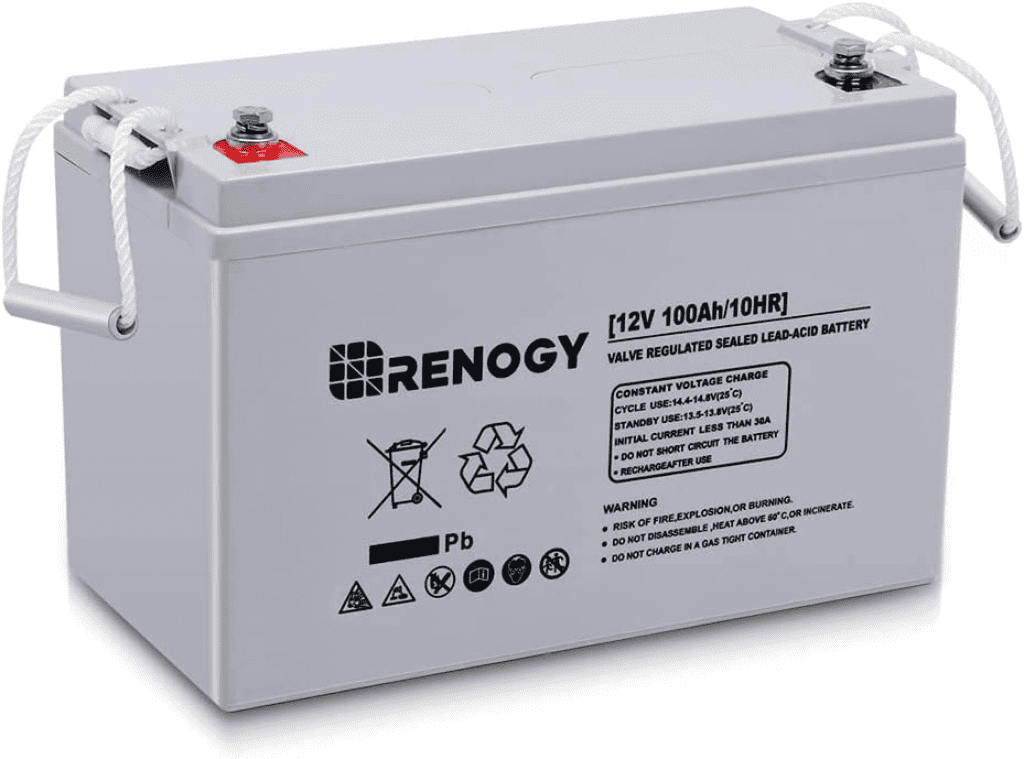
At a glance:
| Brand | Renogy |
| Type | AGM |
| Nominal Voltage | 12V |
| Capacity | 100Ah |
| Max Charge Current | 30A |
| Operating Temperature | Discharge: 5°F to 122°F Charge: 5°F to 104°F |
| Storage Temperature | 5°F to 104°F |
| Weight | 63.9 lbs |
| Dimension | 13.1 x 6.9 x 8.6 inches |
| Warranty | 2 years |
Why we love it:
The Renogy 12 Volt 200Ah Deep Cycle AGM Battery is a powerhouse battery that offers exceptional performance and reliability for various applications. With its impressive capacity and versatility, it is an excellent choice for RV enthusiasts looking for a dependable power source. Here’s a detailed review of the Renogy 12 Volt 200Ah Deep Cycle AGM Battery:
One of the standout features of this battery is its suitability for four-season camping. With an unbeatable operating temperature range, it can withstand extreme weather conditions, ensuring reliable power even in harsh environments. This makes it a reliable choice for RVers who enjoy camping throughout the year.
Additionally, the 200Ah capacity of this battery provides ample power for running basic appliances and more. When paired with a solar system, it can extend the runtime of your appliances, making it ideal for dry camping or off-grid adventures.
For those traveling in groups, where multiple appliances are used simultaneously, the high capacity of the 200Ah model comes in handy. It reduces the risk of overloading your system and ensures everyone can enjoy their devices without compromising power supply.
In terms of value for money, this battery stands out as it offers the same amp hours as some higher-priced lithium-ion batteries but at a more affordable price point. Its well-rounded performance and reliable power delivery make it the Editor’s Choice for its superb value.
The proprietary quinary alloy plates and exclusively treated plate grids contribute to its impressive power capacity and reliable performance. These features enable higher discharge currents and low internal resistance, allowing the battery to power energy-intensive appliances such as vacuum cleaners, ovens, and portable heaters.
With a high rating of 4.6 stars on Amazon, this battery has garnered positive feedback from users. It boasts a low self-discharge rate of below 3% per month at 77°F (25°C), ensuring longer shelf life and reduced frequency of recharging when not in use. It also features advanced valve-regulated technology, ensuring safe usage without the risk of acid leakage or harmful hydrogen gas release.
2. WEIZE 12V 100Ah LiFePO4 Lithium Battery for RV, Off-Grid Application
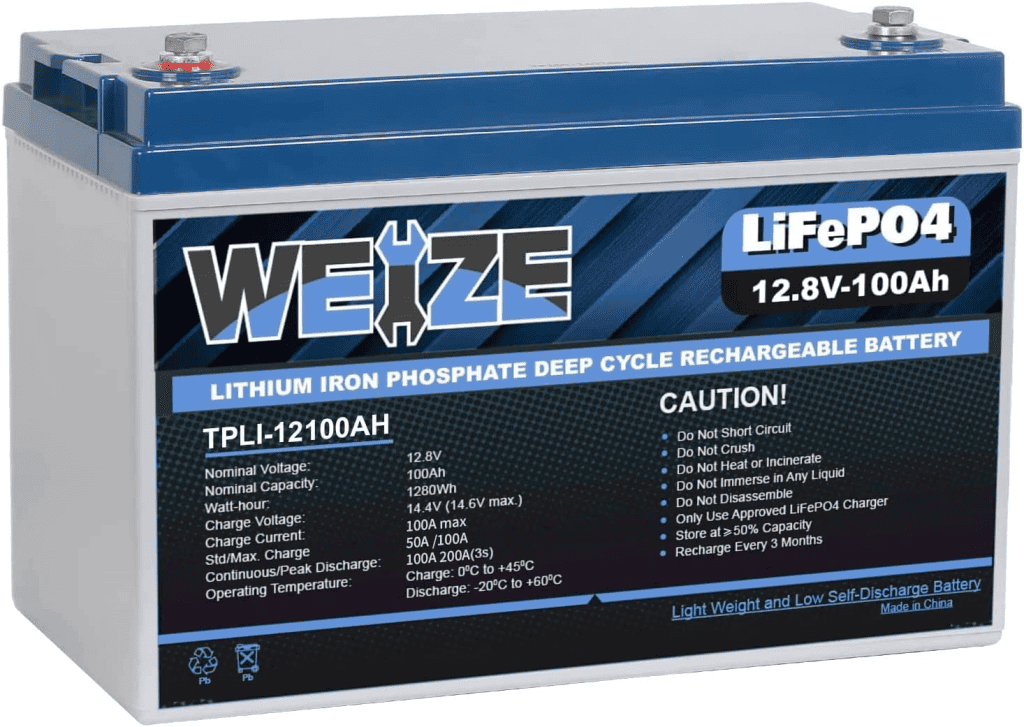
At a glance:
| Brand | WEIZE |
| Type | Lithium |
| Nominal Voltage | 12.8V |
| Capacity | 100Ah |
| Max Charge Current | 100A |
| Recommended DOD | 50% |
| Weight | 26.4 lbs |
| Dimension | 13 x 6.77 x 8.46 inches |
| Warranty | 10 years |
Why we love it:
The Weize 12V 100Ah LiFePO4 Lithium Battery is a highly regarded option for off-grid camping and offers excellent value for money. It may not be the most expensive lithium battery on the market, but it provides exceptional performance and durability, particularly in extreme cold conditions. With a stellar 4.5-star rating from over 1,500 satisfied customers on Amazon, this battery has proven its reliability and quality.
One of the standout features of the Weize LiFePO4 Lithium Battery is its industrial-grade ABS casing, which provides robust protection against vibrations and shocks during travel on rough terrain. The battery’s grid refining technology and thicker plates contribute to its extended standby life and reduced plate grid corrosion speed, ensuring long-lasting performance. It has been praised by countless boondockers for its endurance in both extreme hot and cold conditions, making it suitable for year-round camping.
Despite its slightly heavier weight compared to other 100Ah batteries, customers have found the Weize AGM battery to be relatively lightweight, making it easier to handle. Additionally, it boasts a low self-discharge rate of about 3.3% per month, allowing for extended storage periods when not in use.
The battery comes with a 10-year warranty, demonstrating the manufacturer’s confidence in its longevity and reliability. The built-in Battery Management System (BMS) ensures protection against overcharging, discharging, and short circuits, as well as low and high temperatures. The BMS automatically cuts off the battery in case of any anomalies, providing increased performance and a longer lifespan.
Furthermore, the Weize LiFePO4 Lithium Battery offers versatility and compatibility with various applications, such as fish finders, camping equipment, solar systems, and home alarm systems. Its lightweight design and greater energy density compared to lead-acid batteries make it an ideal upgrade for any 12V deep cycle battery.
Safety is a top priority with this battery, as it is made from non-toxic and environmentally friendly materials. It does not contain acid, making it safe to mount in any position without the risk of leakage or thermal runaway. The user manual provides essential instructions for safe and proper use of the battery.
Overall, the Weize 12V 100Ah LiFePO4 Lithium Battery offers exceptional performance, longevity, and reliability at an affordable price. It is a reliable power source for off-grid camping and a cost-effective alternative to lead-acid batteries, making it a top choice for RV enthusiasts seeking high-quality battery solutions.
3. ExpertPower 12V 100Ah Lithium LiFePO4 Deep Cycle Rechargeable Battery
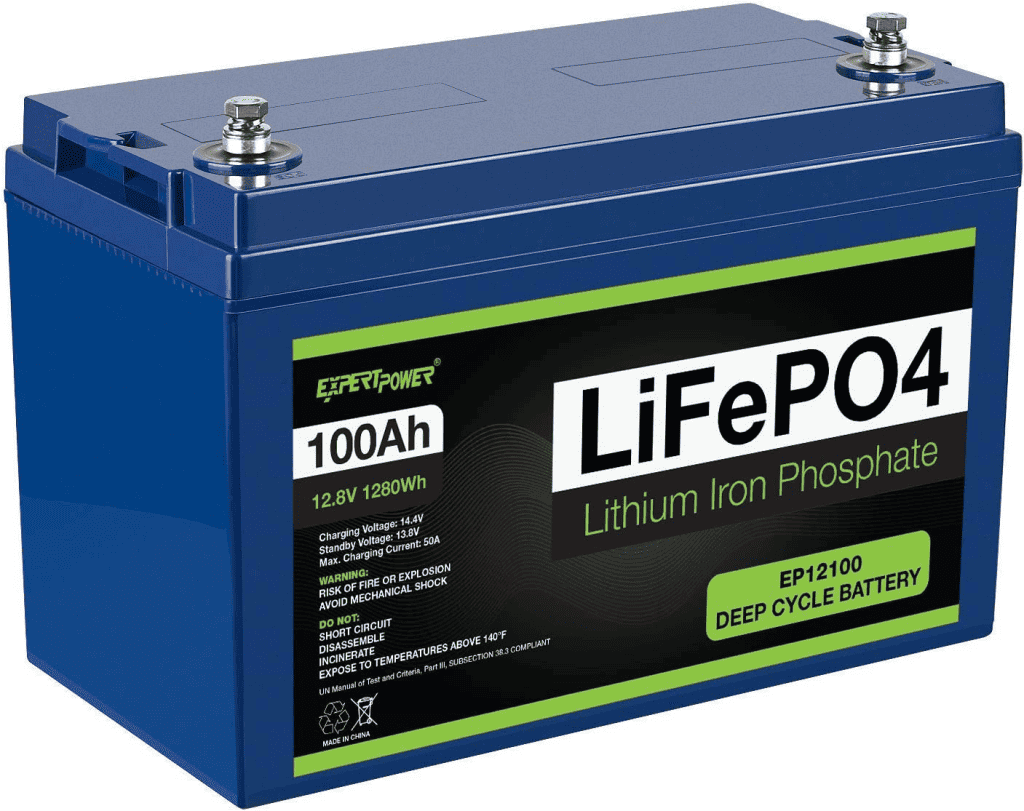
At a glance:
| Brand | ExpertPower |
| Type | LiFePO4 / Lithium |
| Nominal Voltage | 12.8V |
| Capacity | 100Ah |
| Max Charge Current | 100A |
| Weight | 22.6 lbs |
| Dimension | 13 x 6.8 x 8.4 inches |
| Warranty | 1 year |
Why we love it:
The ExpertPower 12V 100Ah Lithium LiFePO4 Deep Cycle Rechargeable Battery is a top-of-the-line choice for RV enthusiasts seeking the best performance and reliability. While the price tag may seem high at $600, the battery’s exceptional durability and long lifespan make it a worthwhile investment.
Firstly, the ExpertPower LiFePO4 battery impressed me by its cycle life. Unlike typical lead-acid batteries that offer around 200-500 cycles and a lifespan of about 3 years, this lithium battery provides an astounding 2500-7000 cycles and a lifespan of 10 years. This means you can discharge the battery to a depth of 95% repeatedly without causing permanent damage, making it highly suitable for dry camping scenarios.
The battery’s flat discharge curve is another advantage, ensuring that it maintains a voltage above 12V for up to 95% of its capacity usage. This results in extended run-time compared to lead-acid batteries, which typically only utilize about 50% of their capacity.
One of the most significant benefits of the ExpertPower LiFePO4 battery is its lightweight design. Weighing only 1/3 of a lead-acid battery, it is an ideal choice for RVs, marine applications, and off-grid setups where mobility and towing capacity are important considerations.
The battery comes with a built-in Battery Management System (BMS) that offers complete protection against overcharging, deep discharge, overloading, overheating, and short circuits. Additionally, it has a low self-discharge rate, ensuring up to 1 year of maintenance-free storage. The BMS also includes a low-temperature cut-off feature, preventing charging when the temperature drops below 23 °F (-5 °C), which helps to safeguard the battery in extreme conditions.
Despite its lightweight design, the ExpertPower LiFePO4 battery delivers a substantial capacity of 100 Ah, making it suitable for powering various RV appliances such as lights, stoves, refrigerators, and charging mobile phones and laptops. When paired with a generator or a solar charging system, this battery provides more than enough power for extended off-grid trips.
Overall, the ExpertPower Lithium LiFePO4 Battery offers outstanding performance, durability, and reliability. It excels in dry camping scenarios and provides excellent value for money. With its long lifespan, lightweight design, and advanced features like the built-in BMS, this battery is a top choice for RV enthusiasts seeking a high-quality power solution.
4. Battle Born Batteries LiFePO4 Deep Cycle Battery
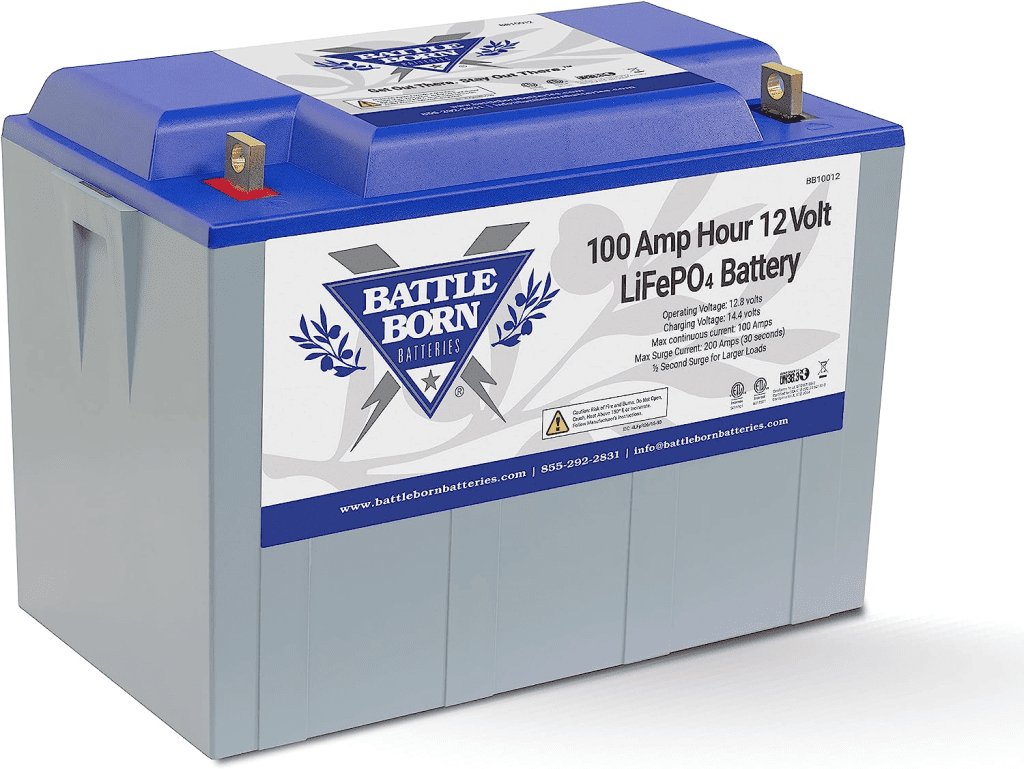
At a glance:
| Brand | Battle Born Batteries |
| Type | LiFePO4 / Lithium |
| Nominal Voltage | 12V |
| Capacity | 100Ah |
| Weight | 31 lbs |
| Dimension | 12.76 × 6.86 × 8.95 inches |
| Warranty | 10 years |
Why we love it:
The Battle Born Batteries LiFePO4 Deep Cycle Battery is a powerhouse of long-lasting and reliable power for a variety of applications. It stands out as one of the best RV batteries on the market, thanks to its impressive features and exceptional performance.
One of the standout qualities of this battery is its longevity. With a lifespan of 10-15 years and the ability to withstand 3,000-5,000 deep discharge cycles, it offers an excellent return on investment. Whether you’re using it for dry camping or other off-grid adventures, this battery will keep you powered up for years to come.
The Battle Born battery is built to handle rugged conditions, making it suitable for a variety of applications, such as campers, vans, boats, trolling motors, and RVs. It is also designed to power industrial, off-grid, and residential backup systems. Its versatility allows for wiring in series or parallel, offering flexibility in meeting your specific power needs.
Safety is a top priority with the built-in Battery Management System (BMS) of the Battle Born battery. This system provides protection against extreme temperatures, high and low voltages, short circuits, and other common causes of battery failure. With this level of internal protection, you can have peace of mind knowing that your battery is safeguarded against potential issues.
When it comes to performance, the Battle Born battery excels in charging efficiency and power storage. It holds a charge well and has a low self-discharge rate of only 3% per month, allowing for longer periods between charging sessions. This, coupled with its ability to handle deep discharges and extreme temperature variations, ensures that you have a reliable power source in various conditions.
While the price point of this battery may be higher compared to other options, the exceptional performance, long lifespan, and 10-year warranty make it a worthwhile investment. Customers have reported using these batteries for up to 8 years and still experiencing reliable performance. When you consider the long-term value and durability, the price becomes justified.
Overall, the Battle Born Batteries LiFePO4 Deep Cycle Battery is an outstanding choice for those seeking a high-quality and reliable power solution for their RV or other off-grid applications. With its exceptional lifespan, versatile design, built-in safety features, and impressive performance, it is a top contender in the market.
5. WindyNation 100 amp-Hour 100AH 12V 12 Volt AGM Deep Cycle
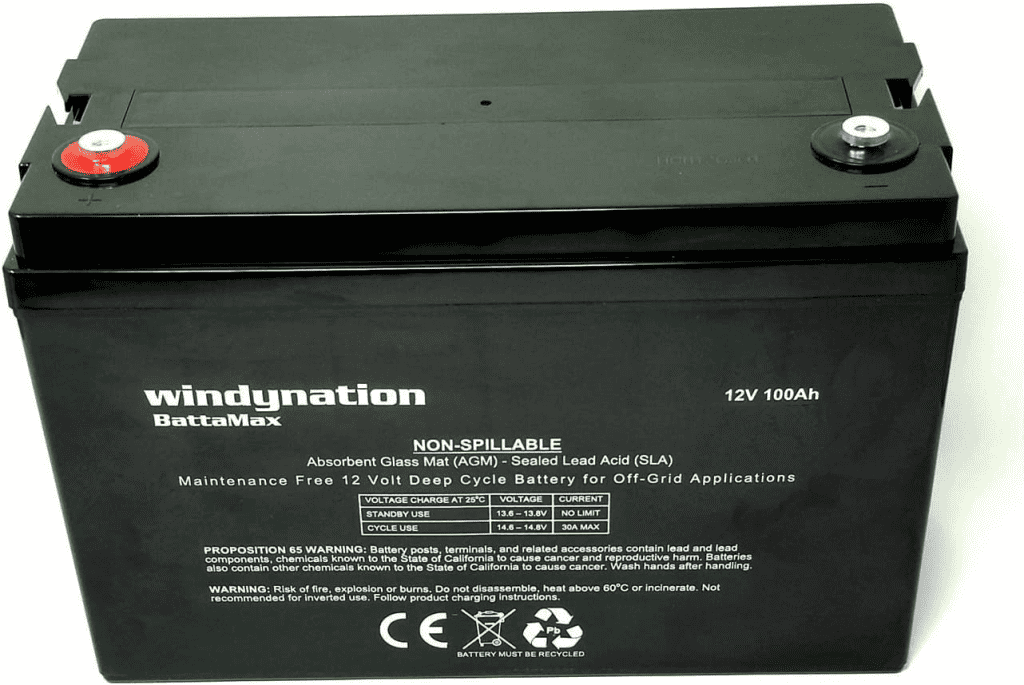
At a glance:
| Brand | WindyNation |
| Type | AGM – Sealed Lead Acid |
| Nominal Voltage | 12V |
| Capacity | 100Ah |
| Weight | 66 lbs |
| Dimension | 13 x 6.8 x 8.7 inches |
| Warranty | 1 year |
Why we love it:
The WindyNation 100 amp-Hour 12V AGM Deep Cycle Battery is an excellent choice for budget-conscious campers looking for a reliable power source. With its affordable price and solid performance, it offers great value for money.
For budget campers, it’s hard to find a 100Ah battery with such well-rounded performance and durability at a price of just over $200. This makes it an ideal choice for beginners or those looking to maximize their budget without compromising on quality.
When it comes to dry camping or extended boondocking trips, the WindyNation battery shines. With its 100Ah rating, it provides ample capacity to power your camping essentials for extended periods. It offers constant power supply even in a wide operating temperature range, making it a reliable option for various camping situations.
This battery possesses the ability to withstand repeated deep discharges while still maintaining a long service life. The manufacturer claims a lifespan of up to 12 years in a moderate environment of around 25°C, and customer reviews support this claim. This longevity can be attributed to its rugged construction and the use of 99.995% pure virgin lead, which allows for maximum power storage and a lower discharge rate. This sets it apart from lower-quality batteries that often use recycled lead.
The WindyNation AGM battery is designed for deep, repetitive discharges, making it suitable for a wide range of off-grid power applications such as solar systems, RVs, UPS, marine power, and portable tools. With a float life of 10 to 12 years at 25 °C, it offers reliable performance over an extended period of time.
RV Battery Buying Guide: Factors to Consider
Choosing the right battery for your RV is essential to ensure reliable power supply on your adventures. Here’s a detailed buying guide to help you make an informed decision:
Power Capacity
The power capacity of an RV battery is measured in amp-hours (Ah). The higher the Ah rating, the longer the battery will last before it needs to be recharged.
When selecting an RV battery, consider your power needs. Assess the appliances and systems you plan to run in your RV, such as lights, fans, refrigerator, water pump, and entertainment devices. Calculate the total power consumption in terms of amp-hours (Ah) or watts (W) to determine the battery capacity required. Choose a battery with a sufficient capacity to meet your needs, considering both regular usage and any anticipated high-demand scenarios.
The power capacity of an RV battery is determined by a number of factors, including the size of the battery, the type of battery, and the depth of discharge (DoD).
The size of the battery is the most important factor affecting power capacity. A larger battery will have a higher Ah rating than a smaller battery. Here are some common RV battery sizes and their corresponding power capacities:
- Group 24 battery: 100-120 Ah
- Group 27 battery: 120-140 Ah
- Group 31 battery: 140-160 Ah
The type of battery also affects power capacity. Lead-acid batteries typically have a lower Ah rating than lithium-ion batteries.
DoD is the percentage of the battery’s capacity that has been used. A lower DoD will result in a higher Ah rating.
For example, a 100 Ah lead-acid battery that is discharged to 50% DoD will have a power capacity of 50 Ah. A 100 Ah lithium-ion battery that is discharged to 50% DoD will have a power capacity of 75 Ah.
Battery Type
There are 4 main types of RV batteries as mentioned above, each with its own advantages and considerations. Consider your needs to choose the right type:
- Flooded Lead Acid batteries are the most common and economical option. However, they require regular maintenance, including electrolyte checks and water refilling, and proper ventilation.
- AGM (Absorbent Glass Mat) batteries are maintenance-free and offer good cycle life. They can handle deep cycling and high discharge rates, making them suitable for RV applications.
- Gel batteries are also maintenance-free and offer good cycle life. They have enhanced resistance to vibration and shock, making them a reliable choice for RVs.
- Lithium-ion batteries for RV are maintenance-free and have a very high cycle life. They provide high energy density, fast charging times, and a longer lifespan. However, they come with a higher price tag.
Reserve Capacity (RC)
Reserve Capacity (RC) is a measure used to assess the available power of a battery over a specified period of time. It indicates the duration for which a battery can deliver a specified amount of current before its voltage drops below a minimum threshold.
Specifically, RC refers to the number of minutes a battery can sustain a load of 25 amps while maintaining a voltage above a predetermined level, typically around 10.5 volts for automotive batteries.
For example, a battery with an RC of 150 minutes can provide 25 amps of current for 150 minutes before its voltage drops to 10.5 volts.
This metric is commonly used in the automotive industry to evaluate the capacity of a battery to power essential vehicle systems during periods of high electrical demand, such as when the engine is off or when there is a significant load on the battery.
A higher RC value signifies a battery’s ability to provide power for a longer duration without falling below the minimum voltage threshold. This is particularly important in applications where a consistent power supply is critical, such as emergency situations or when operating power-hungry devices.
RC is not the same as amp-hours (Ah). Amp-hours measure the total amount of current that a battery can provide before it is fully discharged. RC, on the other hand, measures the amount of time that a battery can provide a constant current before its voltage drops below a specified level.
Reserve Capacity is a useful specification to consider when selecting a battery for applications that require sustained power delivery. It helps determine the battery’s ability to provide electricity over an extended period without recharging. When choosing an RV battery, considering the RC can ensure you have adequate power reserves to support your electrical needs during times when recharging is not immediately available.
For example, if you need a battery that will power your RV while dry camping for a long period of time, you would want to choose an RV battery with a high RC.
Here are some of the factors that affect RC:
- Battery type: Lead-acid batteries typically have a lower RC than lithium-ion batteries.
- Battery size: Larger batteries typically have a higher RC than smaller batteries.
- Battery temperature: Batteries will typically have a lower RC at lower temperatures.

Depth of Discharge (DoD)
Depth of Discharge (DoD) refers to the percentage of a battery’s total capacity that has been discharged. It measures how much energy has been consumed from the battery compared to its full capacity.
For example, if a 100Ah battery has been discharged by 50Ah, the depth of discharge would be 50%. Similarly, if the same battery has been discharged by 80Ah, the depth of discharge would be 80%.
DoD is an important factor in determining the lifespan of a battery. The more deeply a battery is discharged, the shorter its lifespan will be. Regularly discharging beyond the recommended DoD can also reduce the battery’s longevity.
For this reason, it is recommended to discharge a battery to no more than 50% DoD on a regular basis. In fact, each battery type has a recommended DoD for safely discharging without causing damage to the battery. Choose an RV battery type that aligns with your usage patterns and requirements.
There are a few ways to measure DoD. One way is to use a battery monitor that can measure the battery’s voltage. Another way is to use a discharge test.
Here are some of the factors that affect DoD:
- Battery type: Lead-acid batteries typically have a lower DoD than lithium-ion batteries.
- Battery size: Larger batteries typically have a higher DoD than smaller batteries.
- Battery temperature: Batteries will typically have a lower DoD at lower temperatures
Operating Temperature Range
The operating temperature range of RV batteries refers to the range of temperatures within which the battery can safely and effectively operate. It indicates the minimum and maximum temperatures at which the battery can perform optimally, ensuring reliable power output and maintaining its lifespan.
The operating temperature range will vary depending on the type of battery. Different battery chemistries have varying temperature tolerances, and it’s important to consider the operating temperature range to ensure the battery functions properly in the environment where it will be used. Extreme temperatures can affect the battery’s performance and overall lifespan
- Cold weather: Low temperatures can increase the internal resistance of the battery, reducing its ability to deliver power efficiently. It may also cause slower chemical reactions, resulting in a temporary reduction in available capacity.
- Hot weather: High temperatures can accelerate the chemical reactions inside the battery, leading to increased self-discharge, reduced capacity, and shortened lifespan. It can also cause the electrolyte to evaporate more rapidly in flooded lead-acid batteries.
As the cheapest option, Lead-acid batteries have a narrow operating temperature range and can freeze at temperatures below 20°F (-6°C). Lithium-ion batteries have the widest operating temperature range of -40°F to 140°F (-40°C to 60°C).
| Battery Type | Operating Temperature Range |
| Flooded Lead Acid | 20°F to 85°F (-6°C to 30°C) |
| Gel | -22°F to 122°F (-30°C to 50°C) |
| AGM | -40°F to 140°F (-40°C to 60°C) |
| Lithium-ion | -40°F to 140°F (-40°C to 60°C) |
Operating a battery outside of its operating temperature range can damage the battery and shorten its lifespan. For example, operating a lead-acid battery at temperatures below 0°F can cause the battery to freeze and crack. Operating a lithium-ion battery at temperatures above 140°F can cause the battery to overheat and vent.
If you are planning to use your RV in extreme temperatures, you may need to consider using a battery with a wider operating temperature range. You should also check the battery’s manufacturer’s specifications to see what temperatures are safe for the specific battery you are using.
Size & Weight
Size: RV batteries come in a variety of sizes, but the most common sizes are group 24, group 27, and group 31. Group 24 batteries are the smallest, while group 31 batteries are the largest.
Weight: The weight of an RV battery will vary depending on the size and type of battery. Lead-acid batteries typically weigh more than lithium-ion batteries.
Here is a table of the sizes and weights of some common RV batteries:
| Battery Type | Group | Dimensions (in) | Weight (lbs) |
| Lead-acid | Group 24 | 10.75 x 6.6 x 9.25 | 65 |
| Lead-acid | Group 27 | 11.8 x 7.2 x 9.75 | 75 |
| Lead-acid | Group 31 | 13.5 x 8.1 x 10.2 | 85 |
| Lithium-ion | 100 Ah | 10.75 x 6.6 x 6.75 | 45 |
| Lithium-ion | 125 Ah | 12.6 x 7.2 x 7.75 | 55 |
It is important to consider the size and weight of an RV battery when choosing a battery for your RV to make sure it’s compatible with your RV’s setup.
Measure the space where the battery will be installed and verify if the chosen battery will fit comfortably in that location. If you are limited on space, you will need to choose a smaller battery.
Additionally, ensure that the weight of the battery does not exceed the maximum load capacity of your RV. If you are concerned about the weight of the battery, you will need to choose a lighter battery.
Vibration Resistance
Vibration resistance refers to a battery’s ability to withstand and operate effectively in environments with high levels of vibration, such as those experienced in RVs during travel.
It is important to choose an RV battery that has good vibration resistance. This will help to ensure that the battery lasts for a long time and does not suffer any damage from vibrations, especially when you often go on distant road trips.
Price
The price of an RV battery can vary depending on a number of factors, including the type of battery, the capacity of the battery, and the brand of the battery.
- Type of battery: The type of battery is one of the biggest factors that affects the price of an RV battery. Flooded lead-acid batteries are the most common type of RV battery and are relatively inexpensive. AGM batteries are more expensive than flooded lead-acid batteries, but they have a longer lifespan. Lithium-ion batteries are the most expensive type of RV battery, but they have the longest lifespan and are the lightest weight.
- Battery capacity: The capacity of the battery is another factor that affects the price. The capacity of a battery is measured in amp-hours (Ah). A higher amp-hour rating means that the battery can store more power.
- Battery brand: The brand of the battery also affects the price. Some brands of RV batteries are more expensive than others.
Consider your budget when choosing an RV battery. While it’s important to find a battery that fits your budget, remember that investing in a higher-quality battery upfront can lead to longer-term savings due to improved performance and lifespan.
Who Makes The Best Camper Battery?
There are several reputable manufacturers that produce high-quality RV batteries. Here are some well-known and respected brands in the RV battery market:
Battle Born Batteries
Battle Born specializes in lithium-ion batteries designed specifically for RV applications. Lithium-ion technology offers excellent cycle life, and Battle Born batteries are known for their ability to withstand thousands of charge-discharge cycles while maintaining optimal performance.
These batteries are built with high-quality cells and advanced battery management systems to ensure longevity and reliability, making them a top choice for RVers seeking a battery with a long lifespan.
Renogy
Renogy is a company that specializes in solar energy products, including solar panels, charge controllers, inverters, and lithium-ion batteries. They have gained a strong reputation in the solar industry for their high-quality and reliable products.
Renogy’s focus on renewable energy solutions makes them a popular choice for those seeking sustainable power options for their RVs and off-grid applications.
Universal Power Group (UPG)
UPG is a leading supplier and distributor of batteries and power accessories. They offer a wide range of battery options, including sealed lead-acid (SLA), AGM, gel, and lithium-ion batteries. UPG’s batteries are known for their high-quality construction and reliable performance.
Their sealed lead-acid batteries are suitable for various applications, including RVs. As a reputable battery brand, UPG focuses on delivering dependable power solutions for different requirements. Their extensive range of battery options ensures that customers can find the right battery to meet their specific needs, including those related to RV power systems.
Odyssey Batteries
Odyssey offers a range of deep-cycle and dual-purpose batteries designed to deliver long-lasting performance. They utilize advanced Absorbed Glass Mat (AGM) technology, which enhances the battery’s durability and resistance to vibration and shock.
Odyssey batteries are known for their excellent cycle life and high tolerance to deep discharges, making them a reliable choice for RVers seeking a battery that can endure frequent use and deliver reliable power over an extended period.
Trojan Battery Company
Trojan is widely recognized for manufacturing deep-cycle batteries with a focus on long-lasting performance. They have a reputation for using high-quality materials and advanced manufacturing processes, resulting in batteries that can endure a high number of charge-discharge cycles without significant degradation.
Trojan batteries are often praised for their durability and longevity, making them a popular choice for RV owners seeking extended service life.
Lifeline Batteries
Lifeline is a reputable brand known for producing high-quality AGM batteries for marine and RV use. Lifeline batteries are designed to provide exceptional longevity and durability, with a focus on deep cycling capabilities.
Their batteries are built using robust construction methods and high-performance materials, allowing them to handle repeated deep discharges without significant performance degradation. Lifeline batteries are often praised for their extended service life, making them an excellent choice for those seeking long-lasting RV battery performance.
Discover Battery
Discover Battery is a manufacturer that produces a variety of deep-cycle batteries suitable for RV applications. Their batteries are built with robust construction and advanced technologies to provide exceptional cycle life and longevity.
Discover Battery’s focus on quality and performance ensures their batteries can withstand the rigors of deep cycling and provide reliable power for an extended period, making them a brand worth considering for long-lasting RV battery performance.
RV Battery FAQs
How much does a typical RV battery cost?
The cost of a typical RV battery can range from around $100 to $500 or more, depending on factors such as the battery type, capacity, brand. Flooded lead acid batteries are generally the most affordable option ($100-$200), while gel, AGM, and lithium-ion batteries tend to be more expensive. Higher-capacity batteries and those from reputable brands often come with a higher price tag.
How long do RV batteries last?
The lifespan of an RV battery can vary depending on factors such as the battery type, maintenance, and usage. On average, flooded lead acid batteries last around 3 to 5 years, while gel and AGM batteries have a lifespan of 5 to 7 years. Lithium-ion batteries offer the longest lifespan, lasting around 10 to 15 years or more. Proper maintenance, including regular charging, avoiding deep discharges, and following manufacturer guidelines, can help maximize the lifespan of an RV battery.
Does an RV battery charge while plugged in?
Yes, an RV battery can charge while it is plugged into a power source. When an RV is connected to shore power or plugged into an external power outlet, the built-in converter or inverter charger converts the incoming AC power to DC power and directs it to charge the RV battery. This charging process replenishes the battery’s energy and helps maintain its charge level. It’s important to ensure that the RV’s electrical system is properly configured, the charging equipment is functioning correctly, and the battery is in good condition to facilitate effective charging while plugged in.
Why Is my RV battery draining so fast?
There can be several reasons why an RV battery is draining quickly. Some common causes include:
(1) a parasitic draw from appliances or devices that are not properly turned off or disconnected
(2) a faulty electrical component or wiring causing excessive power usage
(3) a deep discharge or aging battery that has reduced capacity
(4) leaving the battery connected while the RV is in storage without a maintenance charger, or
(5) a malfunctioning charging system that is not properly replenishing the battery’s charge.
It is important to troubleshoot and address these issues to prevent excessive battery drain and ensure optimal battery performance.
Does RV battery charge while driving?
Yes, an RV battery can charge while driving. When the RV’s engine is running, the alternator generates electricity that powers the vehicle’s electrical systems and simultaneously charges the RV battery. The alternator converts mechanical energy from the engine into electrical energy, which is directed to the battery to replenish its charge. This charging process allows the RV battery to maintain its power level or recharge if it has been partially discharged.
How can I tell if my RV battery is bad?
There are several signs that can indicate a bad RV battery including:
Insufficient power: If your RV battery struggles to hold a charge or quickly loses power, it could be a sign of a failing battery. You may experience dimming lights, weak appliance performance, or difficulty starting the RV.
Slow cranking: If the RV engine cranks slowly or takes longer to start, it could be a sign of a weak or dying battery. The engine may struggle to turn over, indicating a loss of battery power.
Swollen or leaking battery: Physical signs of damage, such as a swollen or bulging battery case, leakage of electrolyte, or corroded terminals, can indicate a bad battery. These issues can affect the battery’s performance and potentially damage other components.
Inability to hold a charge: If your RV battery fails to hold a charge, even after being properly charged, it could indicate a defective battery. This may be caused by internal damage or depletion of the battery’s capacity.
What is best battery type for RV use?
The best battery type for RV use depends on individual needs and preferences. However, lithium-ion batteries are often considered the top choice for RVs due to their superior performance, longer lifespan, faster charging times, lightweight design, and high energy density. While lithium-ion batteries have a higher upfront cost, they offer numerous benefits such as deep cycling capabilities, low self-discharge rates, and the ability to provide reliable power for extended periods.
